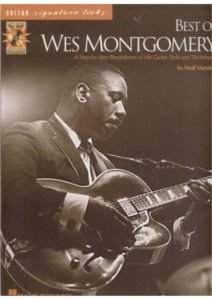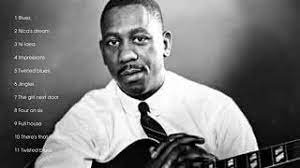Table of Contents:
Great Jazz Guitarists: Wes Montgomery (1923-1968)
Wes Montgomery was the first ( and one of the few ) jazz guitarists to become a star beyond the purview of jazz lovers. His flirtation with pop idioms and audiences was deemed a gross infidelity by his initial ( and most ardent) supporters. “He was very unhappy and disturbed by this attitude,” recalled his disciple, George Benson.
Best Sheet Music download from our Library.
“He died a very sad man.” It’s tempting to depict Wes
Montgomery as a tragic figure, a victim of his own success.
There may be something to this view, but the joyous figure
seen in this video, vividly counters it. Any great talent struck
dead by a heart attack at age 43 is, in a sense, tragic. But
Montgomery’s creative triumphs endure. Critic Marc Gridley
hailed him as “ probably the best hard bop guitarist.”

Joe Pass ranked Montgomery in a trinity alongside Charlie Christian and Django Reinhardt: “ the only three real innovators on the guitar.”
Montgomery’s jazz-pop forays have not diluted his repu-tation among those who really heard him play, as he does in these 1965 performances on the BBC’s Ja zz 6 25 program. Given Montgomery’s enduring impact, it’s remarkable that less than a decade elapsed between his 1959 discovery and his death in 1968. With an understatement analogous to his style, Montgomery succinctly said: “I had to play and tell my story.”
Please, subscribe to our Library. Thank you!
John Leslie Wes Montgomery’s story began in 1925. The Indianapolis native was already grown and married when he fell in love with the guitar in 1943. The reason? It was a recording by a man who had died the previous year, Charlie Christian’s “Solo Flight.” “That was it for me,” Montgomery recalled. “There was no way out . That cat tore everybody’s head up…he said so much on records.” Christian’s records were Montgomery’s constant companion for months as he labored over a guitar in hopes of coming close to Christian’s sound.
“I started off practicing with a plectrum,” he recalled. “I did t his for about 30 days. Then, I decided to plug in my amplifier and see what I was doing. The sound w as too much even for my next-door neighbors. So I took to the back of the house, and began plucking the strings with the fat part of my thumb. This was much quieter. To this technique, I added the trick of playing the melody line in two different registers at the same time —the octave thing.”
“The octave thing” would become Montgomery’s stylistic signature. “Voicing lines in octaves was not new to jazz guitar,” observed Marc Gridley in Jazz Styles, “but Montgomery’s use of this device did much to popularize the approach.”
At first, however, Montgomery was just looking for a gig. “A cat hired me for the Club 440,” he recalled. “I’d play Charlie Christian’s solos, then lay out.” Montgomery worked around Indianapolis, occasionally venturing out on the road with a touring band, and earned his first break in 1948 when Lionel Hampton hired him. “He allowed me to keep my amp on during the entire length of the numbers we played,” Montgomery recalled, “not just during my solos.” Encouraged, Montgomery rose to the occasion:
“I began working hard and experimenting with the techniques,” he recalled, “seeking out the ones that felt good and were most expressive of my thoughts. My explorations continued for quite a while. My technique improved, developing out of particular playing situations. More and more of me passed through my amplifier to those who took time to listen.”
For years, however, listening to Montgomery meant showing up at the Turf Bar or Missile Room in Indianapolis. After a two-year stint with Hampton, he settled into a grueling routine, which divided his energies between daytime employment at a radio parts factory and nightly gigs. Montgomery had seven children and took his parental responsibilities seriously. “Some musicians might…cut off the rest of the world to concentrate exclusively on their thing,” said Montgomery.
“What sort of person would I be,” he asked rhetorically, “if I’d devoted all my time to the instrument…? There are other things going on, you know.” And the grind which kept his family fed also tempered Montgomery the musician: “From all that scuffling,” he reflected, “I learned a lot about discipline as an entertainer.”
In 1959, Cannonball Adderly heard Montgomery at the Missile Room and called Bill Grauer and Orrin Keepnews of Riverside Records with news of his find. Within a matter of weeks, Montgomery and his Missile Room trio had recorded the material for two Riverside albums, Boss Guitar (Riverside RLP 67301) and ‘Round Midnight (Riverside RLP 673099) .
Acclaim was instantaneous: critics compared Montgomery to John Coltrane and Sonny Rollins. down beat awarded him it s New Star honors in 1960, the same year Billboard called Montgomery the “most promising instrumentalist of the year.” That promise was fulfilled on further Riverside recordings and a touring schedule which eventually moved Montgomery to San Francisco.
“When Wes came on the scene,” reflected veteran San Francisco critic Ralph Gleason, “he was so innovative and so powerful that he just swept the other guys away into the studios.”
When Riverside folded in 1964, Montgomery’s talents were enlisted by producer Creed Taylor at the Verve label. There, Montgomery’s music took a turn which disappointed his jazz fans, but which earned him a far broader audience. “He took today’s better pop tunes and played them with such jazz feeling and power that he caught the ear of the pop listener by w h a t he was playing,” wrote Dom Cerulli, “and the imagination of the jazz listener by h ow he was playing what he was playing.”
Not all jazz listeners w ere captivated, but Montgomery’s version of “ Going Out of My Head” claimed the 1966 Grammy for Best Instrumental Jazz Performance.
To his critics, Montgomery said frankly:
“Those who criticize me for playing jazz too simply and such are missing the point. There’s a jazz concept to what I’m doing, but I’m playing popular music, and it should be regarded as such.” Luckily, at least one significant ‘pre-pop’ performance by Montgomery exists on videotape. Pianist Harold Mabern, bassist Arthur Harper, and drummer Jimmy Lovelace join him in a 1965 performance for the BBC’s Jazz 6 25 program.
“Twisted Blues,” a Montgomery composition, gives generous solo space to Mabern and Harper as well as offering a plenitude of Montgomery’s signature shimmery, swooping octaves. “Jingles,” another Montgomery original, showcases the tightness of this quartet driving through bluesy bop terrain. By contrast, the pop chestnut “ Yesterdays” finds its wistful melody swung in a cool way.
(A 1933 Jerome Kern tune, “Yesterdays” debuted in the musical Roberta in which a young Bob Hope appeared in the stage production.)
Montgomery plays it punchy without grandstanding, an art tenor saxophonist Johnny Griffin admired in his old jamming partner: “He had a fantastic creative force,” Griffin said of Montgomery. “Everything he did in life was rounded out, definitive. No waste of energy or emotions.”
The Very Best of Wes Montgomery (Full Album)

